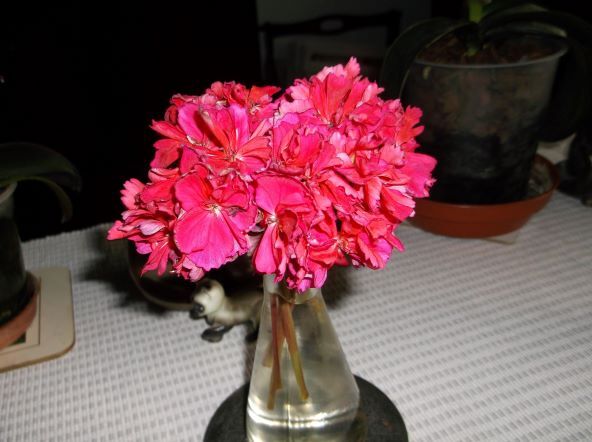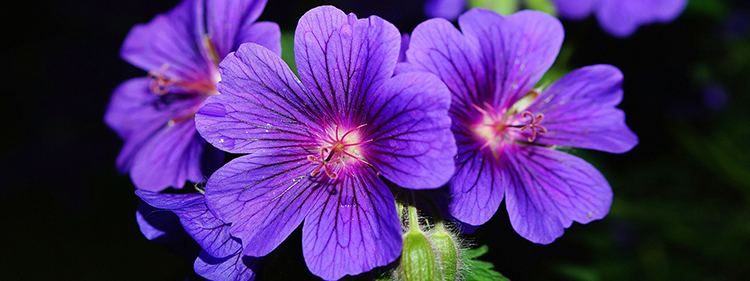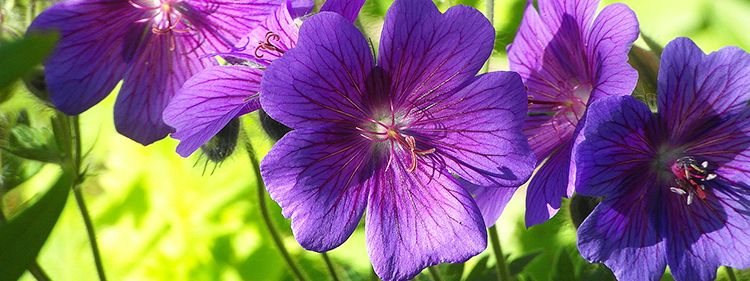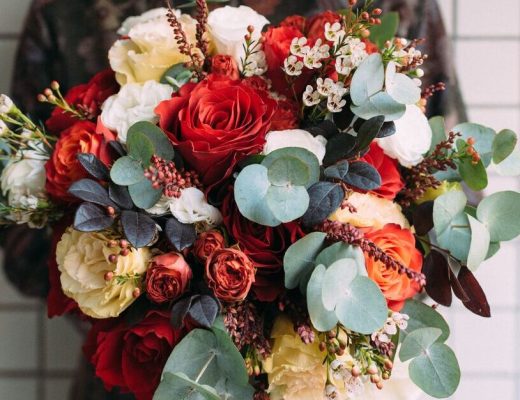Vibrant pop of colour? Tick. Easy to grow? Tick. Attractive blossoms and foliage? Tick. Super easy to propagate and multiply? Tick. The humble Geranium ticks all the boxes. Some varieties have a beautiful scent. Others even edible. They’ll add stunning, bright colour to a space when in bloom and are easy to grow in pots, baskets or directly in the garden. They make the perfect, rewarding starter plant for any budding gardener.
Geranium vs. Pelargonium. Which is which?
‘A rose is a rose, is a rose’ the famous saying goes. Not quite so when it comes to geraniums. Although many varieties look like a Geranium, they might be classified as a Pelargonium.
You can blame a French botanist for this confusion. Originally native to South Africa, Geraniums arrived in 1788 on the Lady Penrhyn from England. A year after those Geraniums arrived in Sydney, he decided to split the genus into Pelargonium and Geranium. What remained is a mix and mingle between the use of the common name, scientific name, and genus – a misplaced nickname.
As a rule of thumb though, Pelargonium are not winter hardy in temperate climates whereas most geraniums are. Additionally, you’ll also find small differences in the shape of petals. In the context of this article, and to keep things simple, we will use ‘geranium’ for both genera.

Did you know that Pelargoniums last for quite some time as a fresh cut flower? The image you see here is of some stems that were cut 5 weeks ago of a mini stellar Kitbridge, taken by our favourite Pelargonium enthusiast, Ken Abel.
How to buy a Geranium
We all choose a plant for different reasons, it’s a thought process perhaps not unlike choosing a new car. For some the decider is how economical a car runs, others top priority is safety and roadworthiness, yet others will decide on look, colour, or its gadgets.

Buying a plant is somewhat similar. We’ll go for the colour and size that looks the most attractive to us, and we’ll check whether it’s an easy plant to care for or not. Ideally, we should also check for healthy leaves and sturdy stems and make sure there are no signs of pests.
About colour: Geranium flowers present from white, to vivid pink and red, to rarer shades of orange and purple. The foliage also comes in an array of attractive shapes and patterns, and in shades of green, whites and maroons.
About size: Geraniums can be any size from groundcover to over a metre tall; some varieties look stunning cascading out of hanging baskets. It really depends on what plant you chose.
About healthy plants: Geraniums are generally hardy and trouble free. But make sure stems are unbroken and there are no dead leaves on the plant. In certain regions Geraniums can suffer from rust and grey mould caused by moisture build-up. However most of these issues can be addressed with a few techniques. These include pruning, watering, and the occasional spray.
How to Plant your Geranium
Now that you’ve chosen your Geranium, it’s time to find the right spot for it and make sure position, soil, sunlight, and temperature are right for your choice. It’s always best to follow the instructions on the label. Each variety is a bit different after all. However here are some general guidelines that will get you started on the right track:
About soil: Choose a well-draining, high quality potting mix if you decide to pop your plant in a basket or a pot; Geraniums don’t like their ‘feet’ to be soggy. If your geranium will get a spot in the garden, make sure you add plenty of compost; especially if you’re dealing with clay soil. A good way to improve drainage outdoors is to mount the soil before planting.
About location: Geraniums are happiest in full sun to partial shade. in fact, they do not like long, cold winters! Those of us lucky enough to have travelled through Europe in summer will remember the colour and abundance of geraniums spilling from windowsills and hanging baskets.
Good to know: Dahlias, roses, grape vine, even corn and beetroot are excellent companion plants to geraniums. Lastly, Geraniums usually look their best as the focal point in containers, mixed with other potted plants or in groups.
How to care for your Geranium
Now you’ve got your plant at home and in the right spot, let’s just quickly go over how to care for it. To be honest, there really isn’t a lot to it. However, did you know that Geraniums are one of the easiest flowering plants to grow and to keep flowering and looking beautiful.

About watering: Be sure to water them regularly and let the soil dry out a bit between watering. The reason for this is too much water can cause the roots to rot.
About light: 5 to 6 hours of direct sunlight, however sheltered from afternoon sun will make them thrive.
About fertiliser: When they are in active growth, it’s recommended to feed them roughly every two months with a fruit and flower fertiliser. Use a slow-release fertiliser if you’ve potted your Geranium. If you are using a liquid fertiliser, feed your Geranium more often, roughly every two weeks during that growth phase.
About preening and pruning: To keep your geranium looking and feeling tidy and healthy, remove any old leaves and spent flowers regularly. Pinching right back to the beginning of a flower bud will reward you with a fuller, healthier and happy bloomer. Lastly, to keep it compact and to encourage lots of new growth, cut the whole plant back by up to a half in autumn.
About overwintering: Geraniums can’t handle long, frosty winters; in the colder parts of the world, they become houseplants during the winter months. If you live in a cooler climate, we have some tips to help you out.
Tips for Winter
– give your plant a good prune and inspect for bugs or diseases first.
– might need to pot up plants from the garden.
– find a spot inside that is sunny. Be sure it isn’t too hot, with low humidity.
– keep the soil moist.
– fertilize lightly in spring and then start to harden off your geraniums for life outdoors again. This is usually a few weeks before the last expected frost.
Good to know: If overwintering inside is just not an option, have cardboard, newspaper, mulch etc. at the ready and protect your plants generously in the garden.

Propagation
Propagation (noun): the breeding of specimens of a plant or animal by natural processes from the parent stock.
What sounds so scientific and elaborate in the dictionary is the easiest process when you’re looking to multiply your geranium stock. Take a cutting!
Here’s how. Cuttings are best taken in autumn. Look for a stem that is matured and has a firm texture. Cut a length of about 20 cm. Take off the lower leaves and any small shoots and half the top foliage (main crown). Leave the stem to dry in the shade for a couple of hours then simply pop it into a propagating mix, readily available at your local garden centre. Lastly; for an extra boost try to dip the cutting into hormone gel first.
Good to know: Geranium’s are the ‘Friendship plant’. A plant grown from your own cutting and presented in a cool pot might make a thoughtful present for a friend.
Pests and diseases
Yes, we have to talk about bug inspection time. Geraniums can handle a bit of tough love and are quite hardy, but little beasts like aphids, spider mites or fungus gnats will try and make themselves at home every now and then. Check leaves regularly for any signs, but definitely in autumn, when preparing your plant for winter.
Additionally, the other one to look out for is leaf rust and grey mould. To avoid this, simply remove affected leaves, ensuring good ventilation, or applying a natural spray will solve the issues.
For a detailed and comprehensive ‘trouble-shooting’ list, we found this website here (https://blog.thompson-morgan.com/geranium-problems/) a great resource.
Scented and Edible
Imagine sprucing up your dish with the aroma of scented and edible geraniums. Or brushing your hands against its foliage to release the aroma of citrus or chocolate! You’ll be amazed at the range of scents Geranium’s have. Bruise their leaves or chop them up, and use them in essential oils, as herbs complementing a meal or to make tea. Use the edible flowers to decorate a cake or in ice cubes, ready for your next cocktail. To find out more about scented, edible varieties, we found the Mudbrick Herb Cottage site an excellent resource. Not only do they provide care instructions, they also give you a run down on the plant’s culinary and medicinal uses!
Geranium varieties – our favs
Some of our favourites are:
– Pelargonium Citronella, with its dainty pink flowers and leaves that can help repel insects when crushed!
– Attar of Rose scented Geranium. Over one metre tall with clusters of pale pink flowers. It’s leaves and stems are used for aromatherapy.

Potted beauties
In many European countries, the Geranium is very much part of the cultural landscape and heritage. They bring summer alive, spilling out of planter boxes in windows, atop water fountains, from hanging baskets under eaves and balconies. Geraniums give you maximum effect and vibrance for very little effort.
Some of our favourites are:
– Ivy Leave Geranium for its excellent cascade of flowers pouring out of hanging baskets, window boxes and containers
– Geranium Pelargonium Allure White. Because you can never go wrong with a crisp and bright white that will either give you a modern white and green container look or contrasts beautifully with any other plant.
– Australian Mystery. Because their dazzling, bright purple and white flowers are a real showstopper. Will make the focal point in a flower bed or in a container.
Natives
Home grown all the way! Australia is home to some stunning and unique flora and fauna.
Some of our favourites are:
– Pelargonium Australe. This beautiful pink flower may be found on sand dunes or cliffs.
– Magenta Storksbill. More of a ground cover, these deep pink lovelies can be found in the forest and woodland areas of NSW, Victoria and South Australia. Which would look stunning as a rockery or bedding display plant.
Resources
Have we tickled your interest? Would you like to learn more about geraniums? They’re certainly one of the most versatile plants and have been lovingly cared for by gardeners for centuries in many parts of the world.
To further help you, we have included a few resources that we found really inspiring, helpful and interesting:
The websites: DayLilliesInAustralia and Mudbrick Herb Cottage provide excellent tips on how to grow scented geraniums. In addition; Herb Cottage has a broad range of organically grown Geraniums for sale. Lastly for a thourough ‘how to’, Bunnings Australia is a good resource for country and region specific planting.
The books: Geraniums: The Complete Encyclopedia (2003) by Faye Brawner my sound a bit like a dictionary but it is a beautifully presented book is aimed at hobby growers across the globe. Available on Amazon. And for those who would like to learn more about the scented Geranium varieties, Scented Geraniums: Knowing, Growing, and Enjoying More Than 100 Varieties by Jim Becker might be an excellent read. Available on Thriftbooks.
The people: Ken Abel is a real Pelargonium enthusiast and some of his plants are prize winners. He also does talks, so it’s worthwhile to follow him on Facebook at https://www.facebook.com/prizepelargoniums65. The Australian Geranium Society https://www.australiangeraniumsociety.org.au/ will also be a good resource for country specific information and workshops.

Your FAQs
Are geraniums toxic to cats?
Yes they are. Geraniums are unfortunately not feline friendly when nibbled on. It’s the linalool and geraniol components, also found in aromatic oils, that can cause a cat to become unwell.
Are geraniums toxic to dogs?
Yes they are. Just to clarify, they are toxic when eaten. Issues resulting from your dog consuming any part of a geranium plant may include skin irritation, a refusal to eat or vomiting. It will be best to consult with a vet.
Why does my geranium have yellow leaves?
Yellow leaves most commonly means you’ve overwatered your plant. If this happens, stop watering your plant and let the soil dry out. Remove the spent leaves. A cold snap or a deficiency in nutrients can also cause yellow leaves. Make sure your plant is sheltered enough or give it an extra feed of fertiliser as needed.
Yellow leaves can also be caused from Pelargoniums being too dry if grown in pots. Propagation can also be done in Spring and is a better time for angles and some of the more trickier scented leaf as they root far quicker with no need for any rooting powder or gel.
How big do geraniums get?
That depends on the variety you choose; they can be anything from a ground cover to a climber reaching hights of well over a metre. That said, Geraniums are also happy to be pruned back quite severely. Check in with your local Garden Centre on what’s available and read labels carefully to make sure the plant you choose will fit the spot or container you want it for.
Why is my geranium not flowering?
Geraniums are usually prolific bloomers, but will not do as well if they’re in a spot with too little light or else if you give them too much fertiliser. If you give them too much of a nutrient boost, you’ll end up with a lush and large green plant, but not many flowers. Both causes are easily fixed though and Geraniums are generally forgiving.
Do hummingbirds like geraniums?
Hummingbirds love nectar-rich blooms and just cannot resist red! So there is your answer right there. Red Geraniums are listed as one of the top flowers to attract hummingbirds to your garden. Another reason to add this amazing plant to your home and garden.
Are geraniums edible?
Yes, many of them are edible for humans. Not only can you enjoy abundant bloom throughout summer, you’ll also have a plant that can give your dishes an extra zing or add some colour to your garden salad. Check our section Scented and Edible.
Meaning of geraniums?
It is generally seen as the flower of friendship. However, in Victorian times, when the‘language of flowers’ was introduced, different varieties of Geraniums had very different meanings. Whereas the Ivy Geranium was code for ‘Your hand for the next dance’, the Scarlet Geranium signified consolation and the Oak-leaved plant true friendship. You really had to know your plants in those days! (Link to floriography article)
Whatever you are using your Geranium for, whether it’ll be adorning an indoor pot, provide that stunning focal point at your front door or add heading scent to a summer’s evening, you will always find this a rewarding plant.
In conclusion; do you have any planting tips or varieties you feel we’ve completely missed out in this article? Let us know, we’d love to hear from you.


